Eucalyptus globulus Coppices in Portugal: Influence of Site and Percentage of Residues Collected for Energy
Abstract
1. Introduction
2. Materials and Methods
2.1. Geographical Scope
2.2. Biomass Production
2.3. Energy Production
3. Results
3.1. Biomass Production
- The location that produces more total and residual biomass is the one with more rainy days per year (Carvoeiro), while the location with the lowest precipitation (Coruche) is the one that produces less biomass (Figure 4);
- The highest amount of residues is attained for the option where 30% of the AGB and 100% of the BGB are removed (FR1.1) and the lowest when 15% of the AGB is removed from the stands (FR3.0) (Figure 5).
3.2. Energy Production
4. Discussion
Author Contributions
Funding
Institutional Review Board Statement
Informed Consent Statement
Conflicts of Interest
Appendix A
| Location | Rotation | AGB | BGB | FR1.0 | FR2.0 | FR3.0 | FR4.0 | FR5.0 | FR1.1 | FR2.1 | FR3.1 | FR4.1 | FR5.1 |
|---|---|---|---|---|---|---|---|---|---|---|---|---|---|
| Site index = 20 | |||||||||||||
| Mortágua | 1 | 104.5 | 26.0 | 31.4 | 26.1 | 15.7 | 20.2 | 28.1 | 31.4 | 26.1 | 15.7 | 20.2 | 28.1 |
| 2 | 141.4 | 35.2 | 42.4 | 35.4 | 21.2 | 25.1 | 36.0 | 42.4 | 35.4 | 21.2 | 25.1 | 36.0 | |
| 3 | 90.9 | 22.6 | 27.3 | 22.7 | 13.6 | 17.3 | 24.2 | 49.9 | 45.3 | 36.2 | 39.9 | 46.8 | |
| Carvoeiro | 1 | 109.1 | 27.1 | 32.7 | 27.3 | 16.4 | 21.1 | 29.3 | 32.7 | 27.3 | 16.4 | 21.1 | 29.3 |
| 2 | 147.6 | 36.7 | 44.3 | 36.9 | 22.1 | 26.0 | 37.4 | 44.3 | 36.9 | 22.1 | 26.0 | 37.4 | |
| 3 | 94.9 | 23.6 | 28.5 | 23.7 | 14.2 | 18.1 | 25.3 | 52.1 | 47.3 | 37.8 | 41.7 | 48.9 | |
| Aldeia do Mato | 1 | 100.0 | 24.9 | 30.0 | 25.0 | 15.0 | 19.4 | 26.9 | 30.0 | 25.0 | 15.0 | 19.4 | 26.9 |
| 2 | 135.5 | 33.7 | 40.7 | 33.9 | 20.3 | 24.0 | 34.4 | 40.7 | 33.9 | 20.3 | 24.0 | 34.4 | |
| 3 | 87.0 | 21.6 | 26.1 | 21.8 | 13.1 | 16.6 | 23.1 | 47.7 | 43.4 | 34.7 | 38.2 | 44.7 | |
| Coruche | 1 | 96.1 | 23.9 | 28.8 | 24.0 | 14.4 | 18.6 | 25.9 | 28.8 | 24.0 | 14.4 | 18.6 | 25.9 |
| 2 | 129.9 | 32.3 | 39.0 | 32.5 | 19.5 | 23.1 | 33.1 | 39.0 | 32.5 | 19.5 | 23.1 | 33.1 | |
| 3 | 83.7 | 20.8 | 25.1 | 20.9 | 12.6 | 16.0 | 22.3 | 45.9 | 41.7 | 33.4 | 36.8 | 43.1 | |
| Site index = 17 | |||||||||||||
| Mortágua | 1 | 73.9 | 18.4 | 22.2 | 18.5 | 11.1 | 15.1 | 20.5 | 22.2 | 18.5 | 11.1 | 15.1 | 20.5 |
| 2 | 105.2 | 26.2 | 31.6 | 26.3 | 15.8 | 19.9 | 27.8 | 31.6 | 26.3 | 15.8 | 19.9 | 27.8 | |
| 3 | 63.6 | 15.8 | 19.1 | 15.9 | 9.5 | 12.9 | 17.5 | 34.9 | 31.7 | 25.3 | 28.7 | 33.3 | |
| Carvoeiro | 1 | 77.1 | 19.2 | 23.1 | 19.3 | 11.6 | 15.8 | 21.4 | 23.1 | 19.3 | 11.6 | 15.8 | 21.4 |
| 2 | 109.8 | 27.3 | 32.9 | 27.5 | 16.5 | 20.7 | 28.9 | 32.9 | 27.5 | 16.5 | 20.7 | 28.9 | |
| 3 | 66.4 | 16.5 | 19.9 | 16.6 | 10.0 | 13.3 | 18.2 | 36.4 | 33.1 | 26.5 | 29.8 | 34.7 | |
| Aldeia do Mato | 1 | 70.7 | 17.6 | 21.2 | 17.7 | 10.6 | 14.4 | 19.6 | 21.2 | 17.7 | 10.6 | 14.4 | 19.6 |
| 2 | 100.9 | 25.1 | 30.3 | 25.2 | 15.1 | 19.2 | 26.7 | 30.3 | 25.2 | 15.1 | 19.2 | 26.7 | |
| 3 | 60.8 | 15.1 | 18.2 | 15.2 | 9.1 | 12.3 | 16.8 | 33.3 | 30.3 | 24.2 | 27.4 | 31.9 | |
| Coruche | 1 | 68.0 | 16.9 | 20.4 | 17.0 | 10.2 | 14.0 | 19.0 | 20.4 | 17.0 | 10.2 | 14.0 | 19.0 |
| 2 | 96.8 | 24.1 | 29.0 | 24.2 | 14.5 | 18.4 | 25.6 | 29.0 | 24.2 | 14.5 | 18.4 | 25.6 | |
| 3 | 58.6 | 14.6 | 17.6 | 14.7 | 8.8 | 11.9 | 16.2 | 32.2 | 29.3 | 23.4 | 26.5 | 30.8 | |
| Location | Rotation | FR1.0 | FR2.0 | FR3.0 | FR4.0 | FR5.0 | FR1.1 | FR2.1 | FR3.1 | FR4.1 | FR5.1 |
|---|---|---|---|---|---|---|---|---|---|---|---|
| Site index = 20 | |||||||||||
| Mortágua | 1 | 1818 | 2188 | 3637 | 2827 | 2032 | 1818 | 2188 | 3637 | 2827 | 2032 |
| 2 | 1347 | 1613 | 2693 | 2275 | 1586 | 1347 | 1613 | 2693 | 2275 | 1586 | |
| 3 | 2091 | 2515 | 4198 | 3300 | 2359 | 1144 | 1260 | 1577 | 1431 | 1220 | |
| Carvoeiro | 1 | 1746 | 2091 | 3481 | 2706 | 1949 | 1746 | 2091 | 3481 | 2706 | 1949 |
| 2 | 1289 | 1547 | 2584 | 2196 | 1527 | 1289 | 1547 | 2584 | 2196 | 1527 | |
| 3 | 2003 | 2409 | 4021 | 3154 | 2257 | 1096 | 1207 | 1510 | 1369 | 1168 | |
| Aldeia do Mato | 1 | 1903 | 2284 | 3806 | 2943 | 2123 | 1903 | 2284 | 3806 | 2943 | 2123 |
| 2 | 1403 | 1684 | 2813 | 2379 | 1660 | 1403 | 1684 | 2813 | 2379 | 1660 | |
| 3 | 2188 | 2619 | 4358 | 3440 | 2472 | 1197 | 1316 | 1645 | 1495 | 1277 | |
| Coruche | 1 | 1983 | 2379 | 3965 | 3070 | 2204 | 1983 | 2379 | 3965 | 3070 | 2204 |
| 2 | 1464 | 1757 | 2928 | 2472 | 1725 | 1464 | 1757 | 2928 | 2472 | 1725 | |
| 3 | 2275 | 2732 | 4531 | 3569 | 2560 | 1244 | 1369 | 1709 | 1552 | 1325 | |
| Site index = 17 | |||||||||||
| Mortágua | 1 | 2575 | 3090 | 5151 | 3781 | 2785 | 2575 | 3090 | 5151 | 3781 | 2785 |
| 2 | 1809 | 2171 | 3618 | 2866 | 2055 | 1809 | 2171 | 3618 | 2866 | 2055 | |
| 3 | 2992 | 3591 | 5985 | 4435 | 3256 | 1637 | 1801 | 2253 | 1991 | 1713 | |
| Carvoeiro | 1 | 2468 | 2962 | 4937 | 3625 | 2669 | 2468 | 2962 | 4937 | 3625 | 2669 |
| 2 | 1733 | 2080 | 3467 | 2758 | 1974 | 1733 | 2080 | 3467 | 2758 | 1974 | |
| 3 | 2866 | 3440 | 5733 | 4285 | 3138 | 1568 | 1725 | 2158 | 1914 | 1646 | |
| Aldeia do Mato | 1 | 2692 | 3230 | 5384 | 3958 | 2915 | 2692 | 3230 | 5384 | 3958 | 2915 |
| 2 | 1886 | 2263 | 3772 | 2978 | 2138 | 1886 | 2263 | 3772 | 2978 | 2138 | |
| 3 | 3130 | 3756 | 6261 | 4633 | 3404 | 1713 | 1884 | 2357 | 2082 | 1791 | |
| Coruche | 1 | 2799 | 3359 | 5598 | 4078 | 3011 | 2799 | 3359 | 5598 | 4078 | 3011 |
| 2 | 1966 | 2359 | 3932 | 3103 | 2229 | 1966 | 2359 | 3932 | 3103 | 2229 | |
| 3 | 3248 | 3897 | 6496 | 4798 | 3529 | 1774 | 1952 | 2441 | 2155 | 1855 | |
References
- Potts, B.M.; Vaillancourt, R.E.; Jordan, G.J.; Dutkowski, G.W.; Costa e Silva, J.; McKinnon, G.E.; Steane, D.A.; Volker, P.W.; Lopez, G.A.; Apiolaza, L.A.; et al. Exploration of the Eucalyptus globulus Gene Pool. In Eucalyptus in a Changing World, Proceedings of the IUFRO Conference, Aveiro, Portugal, 11–15 October 2004; Borralho, N.M.G., Pereira, J.S., Marques, C., Coutinho, J., Madeira, M., Tomé, M., Eds.; RAIZ, Instituto Investigação de Floresta e Papel: Aveiro, Portugal, 2004; pp. 46–61. [Google Scholar]
- IFN6. 6ºInventário Florestal Nacional; Instituto da Conservação da Natureza e das Florestas: Lisbon, Portugal, 2015; p. 26. [Google Scholar]
- Águas, A.; Ferreira, A.; Maia, P.; Fernandes, P.M.; Roxo, L.; Keizer, J.; Silva, J.S.; Rego, F.C.; Moreira, F. Natural establishment of Eucalyptus globulus Labill. in burnt stands in Portugal. For. Ecol. Manag. 2014, 323, 47–56. [Google Scholar] [CrossRef]
- APA. National Forestry Accounting Plan. Portugal 2021–2025; APA—Agência Portuguesa de Ambiente: Lisbon, Portugal, 2020.
- Martire, S.; Castellani, V.; Sala, S. Carrying capacity assessment of forest resources: Enhancing environmental sustainability in energy production at local scale. Resour. Conserv. Recycl. 2015, 94, 11–20. [Google Scholar] [CrossRef]
- Pérez, S.; Renedo, C.; Ortiz, A.; Mañana, M.; Silió, D. Energy evaluation of the Eucalyptus globulus and the Eucalyptus nitens in the north of Spain (Cantabria). Thermochim. Acta 2006, 451, 57–64. [Google Scholar] [CrossRef]
- Rothe, A.; Moroni, M.; Neyland, M.; Wilnhammer, M. Current and potential use of forest biomass for energy in Tasmania. Biomass-Bioenergy 2015, 80, 162–172. [Google Scholar] [CrossRef]
- Dias, J.; Azevedo, J. Evaluation of Biomass Residuals in Portugal Mainland. In New and Renewable Energy Technologies for Sustainable Development; CRC Press: London, UK, 2020; pp. 215–228. [Google Scholar]
- López-Rodríguez, F.; Atanet, C.P.; Blázquez, F.C.; Celma, A.R. Spatial assessment of the bioenergy potential of forest residues in the western province of Spain, Caceres. Biomass-Bioenergy 2009, 33, 1358–1366. [Google Scholar] [CrossRef]
- DGEG. Balanço Energético 2019; DGEG: Lisboa, Portugal, 2020; p. 17.
- Malico, I.; Gonçalves, A.C.; Sousa, A.M.O. Evergreen oak biomass residues for firewood. In Forest Biomass–From Trees to Energy; Gonçalves, A.C., Sousa, A., Malico, I., Eds.; IntechOpen: London, UK, 2021; pp. 87–103. [Google Scholar] [CrossRef]
- CELPA. Boletim Estatístico 2019; CELPA—Associação da Indústria Papeleira: Lisbon, Portugal, 2020; p. 368. [Google Scholar]
- Database of Electric Power Plants Based on Renewable Energy Sources. Available online: https://e2p.inegi.up.pt/ (accessed on 14 March 2021).
- Barreiro, S.; Tomé, M. Analysis of the Impact of the Use of Eucalyptus Biomass for Energy on Wood Availability for Eucalyptus Forest in Portugal: A Simulation Study. Ecol. Soc. 2012, 17, 14. [Google Scholar] [CrossRef][Green Version]
- Bryngemark, E. Second generation biofuels and the competition for forest raw materials: A partial equilibrium analysis of Sweden. For. Policy Econ. 2019, 109, 102022. [Google Scholar] [CrossRef]
- Lauri, P.; Forsell, N.; Gusti, M.; Korosuo, A.; Havlik, P.; Obersteiner, M. Global Woody Biomass Harvest Volumes and Forest Area Use Under Different SSP-RCP Scenarios. J. For. Econ. 2019, 34, 285–309. [Google Scholar] [CrossRef]
- Malico, I.; Pereira, R.N.; Gonçalves, A.C.; Sousa, A.M.O. Current status and future perspectives for energy production from solid biomass in the European industry. Renew. Sustain. Energy Rev. 2019, 112, 960–977. [Google Scholar] [CrossRef]
- Hesselink, T.P. Increasing pressures to use forest biomass: A conservation viewpoint. For. Chron. 2010, 86, 28–35. [Google Scholar] [CrossRef]
- Cook, J.; Beyea, J. Bioenergy in the United States: Progress and possibilities11Based on the final report for NREL Subcontract No. ACD-5-15212-01 with the National Audubon Society. Biomass-Bioenergy 2000, 18, 441–455. [Google Scholar] [CrossRef]
- Swank, W.; Vose, J.; Elliott, K. Long-term hydrologic and water quality responses following commercial clearcutting of mixed hardwoods on a southern Appalachian catchment. For. Ecol. Manag. 2001, 143, 163–178. [Google Scholar] [CrossRef]
- Berndes, G.; Hoogwijk, M.; Broek, R.V.D. The contribution of biomass in the future global energy supply: A review of 17 studies. Biomass-Bioenergy 2003, 25, 1–28. [Google Scholar] [CrossRef]
- Belleau, A.; Brais, S.; Paré, D. Soil Nutrient Dynamics after Harvesting and Slash Treatments in Boreal Aspen Stands. Soil Sci. Soc. Am. J. 2006, 70, 1189–1199. [Google Scholar] [CrossRef]
- Shepard, J.P. Water quality protection in bioenergy production: The US system of forestry Best Management Practices. Biomass-Bioenergy 2006, 30, 378–384. [Google Scholar] [CrossRef]
- Egnell, G. A review of Nordic trials studying effects of biomass harvest intensity on subsequent forest production. For. Ecol. Manag. 2017, 383, 27–36. [Google Scholar] [CrossRef]
- Raulund-Rasmussen, K.; Stupak, I.; Clarke, N.; Callesen, I.; Helmisaari, H.S.; Karltun, E.; Varnagiryte-Kabasinskiene, I. Effects of very intensive forest biomass harvesting on short and long term site productivity. In Sustainable Use of Forest Biomass for Energy: A Synthesis with Focus on the Baltic and Nordic Region. Managing Forest Ecosystems; Röser, D., Asikainen, A., Raulund-Rasmussen, K., Stupak, I., Eds.; Springer: Dordrecht, The Netherlands, 2008; Volume 12, pp. 29–78. [Google Scholar] [CrossRef]
- Madeira, M.; Cortez, N.; Azevedo, C.; Magalhães, M.C.; Ribeiro, C.; Fabião, A. As plantações de eucalipto e o solo. In O Eucaliptal em Portugal; Alves, A.M., Pereira, J.S., Silva, J.M.N., Eds.; ISAPress: Lisbon, Portugal, 2007; pp. 137–174. [Google Scholar]
- Pyttel, P.L.; Köhn, M.; Bauhus, J. Effects of different harvesting intensities on the macro nutrient pools in aged oak coppice forests. For. Ecol. Manag. 2015, 349, 94–105. [Google Scholar] [CrossRef]
- Junior, H.J.E.; De Melo, R.X.; Sartori, M.M.P.; Guerra, S.P.S.; Ballarin, A.W. Sustainable use of eucalypt biomass grown on short rotation coppice for bioenergy. Biomass-Bioenergy 2016, 90, 15–21. [Google Scholar] [CrossRef]
- Fernandes, U.; Costa, M. Potential of biomass residues for energy production and utilization in a region of Portugal. Biomass-Bioenergy 2010, 34, 661–666. [Google Scholar] [CrossRef]
- Malico, I.; Carrajola, J.; Gomes, C.P.; Lima, J. Biomass residues for energy production and habitat preservation. Case study in a montado area in Southwestern Europe. J. Clean. Prod. 2016, 112, 3676–3683. [Google Scholar] [CrossRef]
- Burkhart, H.E.; Tomé, M. Modeling Forest Trees and Stands; Springer Science & Business Media: Berlin/Heidelberg, Germany, 2012. [Google Scholar]
- Correia, A.V.; Oliveira, A.C. Principais Espécies Florestais com Interesse Para Portugal: Zonas de Influência Atlântica; Direcção-Geral das Florestas: Lisboa, Portugal, 2003; p. 322. [Google Scholar]
- WebGlobulus. Available online: http://home.isa.utl.pt/~joaopalma/modelos/webglobulus/ (accessed on 21 September 2020).
- Tomé, M.; Ribeiro, F.; Soares, P. O Modelo Globulus 2.1. Relatórios Técnico-Científicos do GIMREF, no. 1/2001; Departamento Engenharia Florestal, ISA: Lisbon, Portugal, 2001; p. 69. [Google Scholar]
- Tomé, M.; Oliveira, T.; Soares, P. O Modelo Globulus 3.0. Publicações GIMREF—RC2/2006; Universidade Técnica de Lisboa, Instituto Superior de Agronomia, Centro de Estudos Florestais: Lisbon, Portugal, 2006; p. 23. [Google Scholar]
- Röser, D.; Asikainen, A.; Stupak, I.; Pasanen, K. Forest energy resources and potentials. In Sustainable Use of Forest Biomass for Energy: A Synthesis with Focus on the Baltic and Nordic Region. Managing Forest Ecosystems; Röser, D., Asikainen, A., Raulund-Rasmussen, K., Stupak, I., Eds.; Springer: Dordrecht, The Netherlands, 2008; Volume 12, pp. 9–28. [Google Scholar] [CrossRef]
- Smith, W.B.; Miles, P.D.; Perry, C.H.; Pugh, S.A. Forest Resources of the United States, 2007; U.S. Department of Agriculture, Forest Service: Washington, DC, USA, 2009; p. 336. [Google Scholar]
- R Core Team. R: A Language and Environment for Statistical Computing; R Foundation for Statistical Computing: Vienna, Austria, 2020. [Google Scholar]
- Demirbaş, A. Calculation of higher heating values of biomass fuels. Fuel 1997, 76, 431–434. [Google Scholar] [CrossRef]
- Jenkins, B.M.; Baxter, L.L.; Miles, T.R. Combustion properties of biomass. Fuel Process. Technol. 1998, 54, 17–46. [Google Scholar] [CrossRef]
- Quaak, P.; Knoef, H.; Stassen, H. Energy from Biomass: A Review of Combustion and Gasification Technologies; The World Bank: Washington, DC, USA, 1999; p. 78. [Google Scholar] [CrossRef]
- Strezov, V. Properties of biomass fuels. In Biomass Processing Technologies; Strezov, V., Evans, T.J., Eds.; CRC Press: Boca Raton, FL, USA, 2014; pp. 1–32. [Google Scholar]
- Vassilev, S.V.; Vassileva, C.G.; Vassilev, V.S. Advantages and disadvantages of composition and properties of biomass in comparison with coal: An overview. Fuel 2015, 158, 330–350. [Google Scholar] [CrossRef]
- Arteaga-Pérez, L.E.; Segura, C.; Bustamante-García, V.; Cápiro, O.G.; Jiménez, R. Torrefaction of wood and bark from Eucalyptus globulus and Eucalyptus nitens: Focus on volatile evolution vs. feasible temperatures. Energy 2015, 93, 1731–1741. [Google Scholar] [CrossRef]
- Phyllis2, Database for Biomass and Waste. Available online: https://www.ecn.nl/phyllis2 (accessed on 24 April 2021).
- Miranda, I.; Almeida, M.; Pereira, H. Provenance and site variation of wood density in Eucalyptus globulus Labill. at harvest age and its relation to a non-destructive early assessment. For. Ecol. Manag. 2001, 149, 235–240. [Google Scholar] [CrossRef]
- Gominho, J.; Lourenço, A.; Miranda, I.; Pereira, H. Chemical and fuel properties of stumps biomass from Eucalyptus globulus plantations. Ind. Crop. Prod. 2012, 39, 12–16. [Google Scholar] [CrossRef]
- Vicente, E.; Tarelho, L.; Teixeira, E.; Duarte, M.; Nunes, T.; Colombi, C.; Gianelle, V.; Da Rocha, G.; De La Campa, A.S.; Alves, C. Emissions from the combustion of eucalypt and pine chips in a fluidized bed reactor. J. Environ. Sci. 2016, 42, 246–258. [Google Scholar] [CrossRef]
- Gonçalves, A.C.; Malico, I.; Sousa, A.M.O. Energy production from forest biomass: An overview. In Forest Biomass—From Trees to Energy; Gonçalves, A.C., Sousa, A., Malico, I., Eds.; IntechOpen: London, UK, 2021; pp. 1–23. [Google Scholar] [CrossRef]
- Altri. Available online: http://www.altri.pt/en (accessed on 19 February 2019).
- Patrão, G. The Portuguese Energy Strategy and the role of Biomass. Workshop BIOGAIR: Biomass on the Portuguese Energy Sector; Universidade de Aveiro: Aveiro, Portugal, 13 May 2011. [Google Scholar]
- Silva, J.P.; Teixeira, J.; Teixeira, S.; Preziati, S.; Cassiano, J. CFD Modeling of Combustion in Biomass Furnace. Energy Procedia 2017, 120, 665–672. [Google Scholar] [CrossRef]
- David, J.S.; David, T.S.; Valente, F. O eucaliptal e os recursos hídricos. In O Eucaliptal em Portugal; Alves, A.M., Pereira, J.S., Silva, J.M.N., Eds.; ISAPress: Lisbon, Portugal, 2007; pp. 113–135. [Google Scholar]
- Persson, T.; Egnell, G. Stump harvesting for bioenergy: A review of climatic and environmental impacts in northern Europe and America. Wiley Interdiscip. Rev. Energy Environ. 2018, 7, e307. [Google Scholar] [CrossRef]
- Madeira, A.C.; Madeira, M.; Fabião, A.; Marques, P.; Carneiro, M. Impact of harvest residues, fertilisers and N-fixing plants on growth and nutritional status of young Eucalyptus globulus plantations, under Mediterranean conditions. Eur. J. For. Res. 2010, 129, 591–601. [Google Scholar] [CrossRef]
- Carneiro, M.; Fabião, A.; Martins, M.C.; Cerveira, C.; Santos, C.; Nogueira, C.; Lousa, M.; Hilario, L.; Fabião, A.; Abrantes, M.; et al. Species richness and biomass of understory vegetation in a Eucalyptus globulus Labill. coppice as affected by slash management. Eur. J. For. Res. 2006, 126, 475–480. [Google Scholar] [CrossRef]
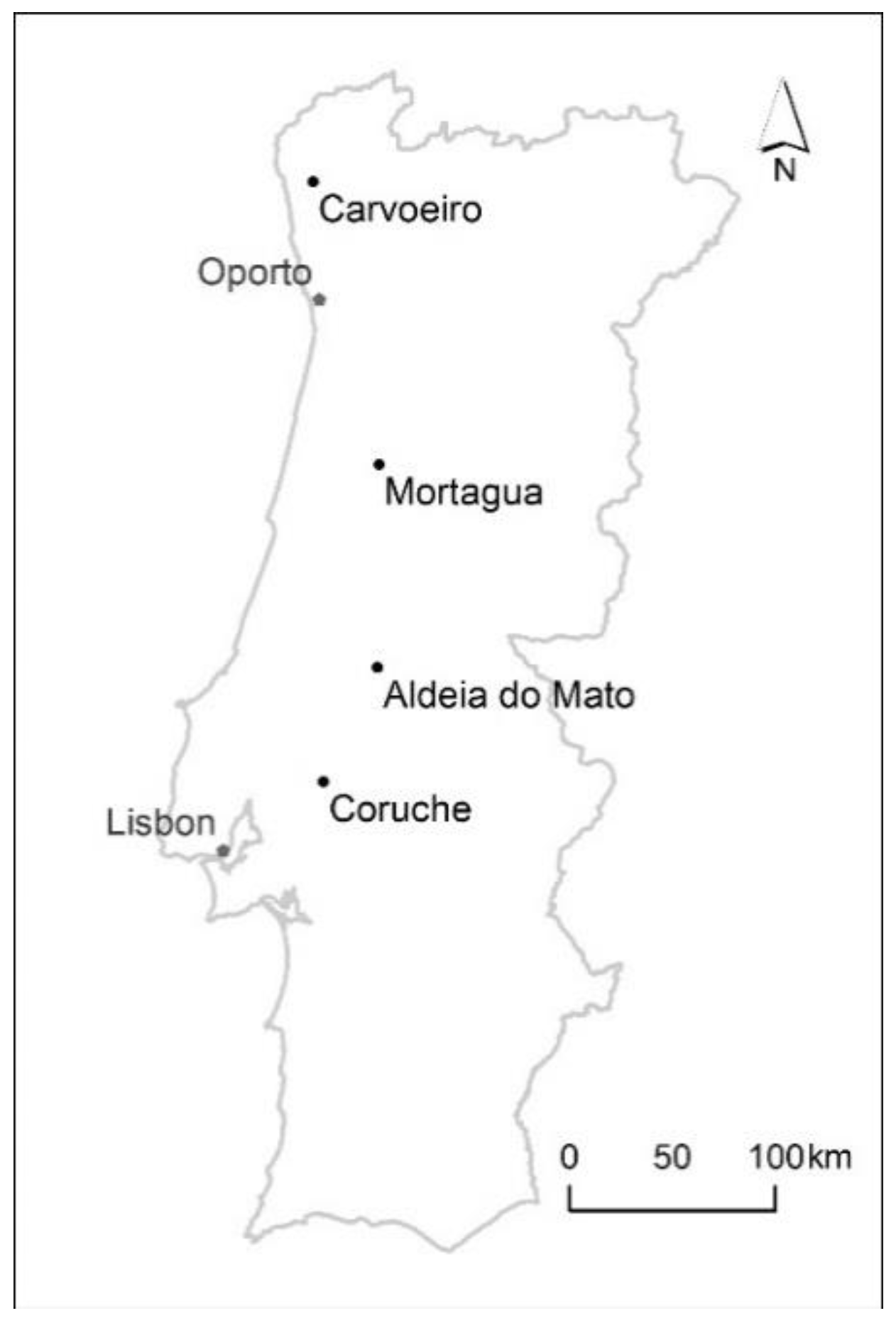
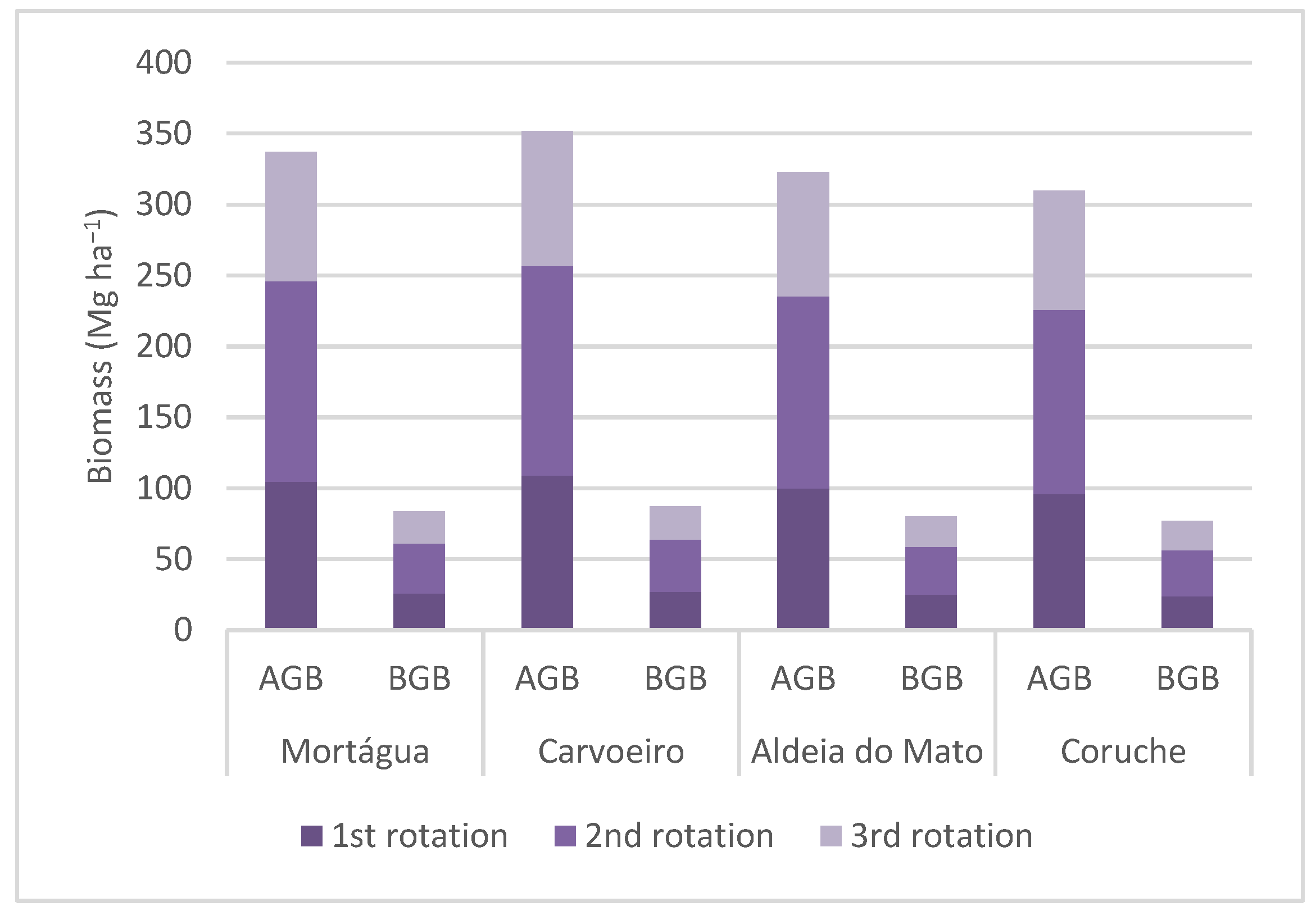

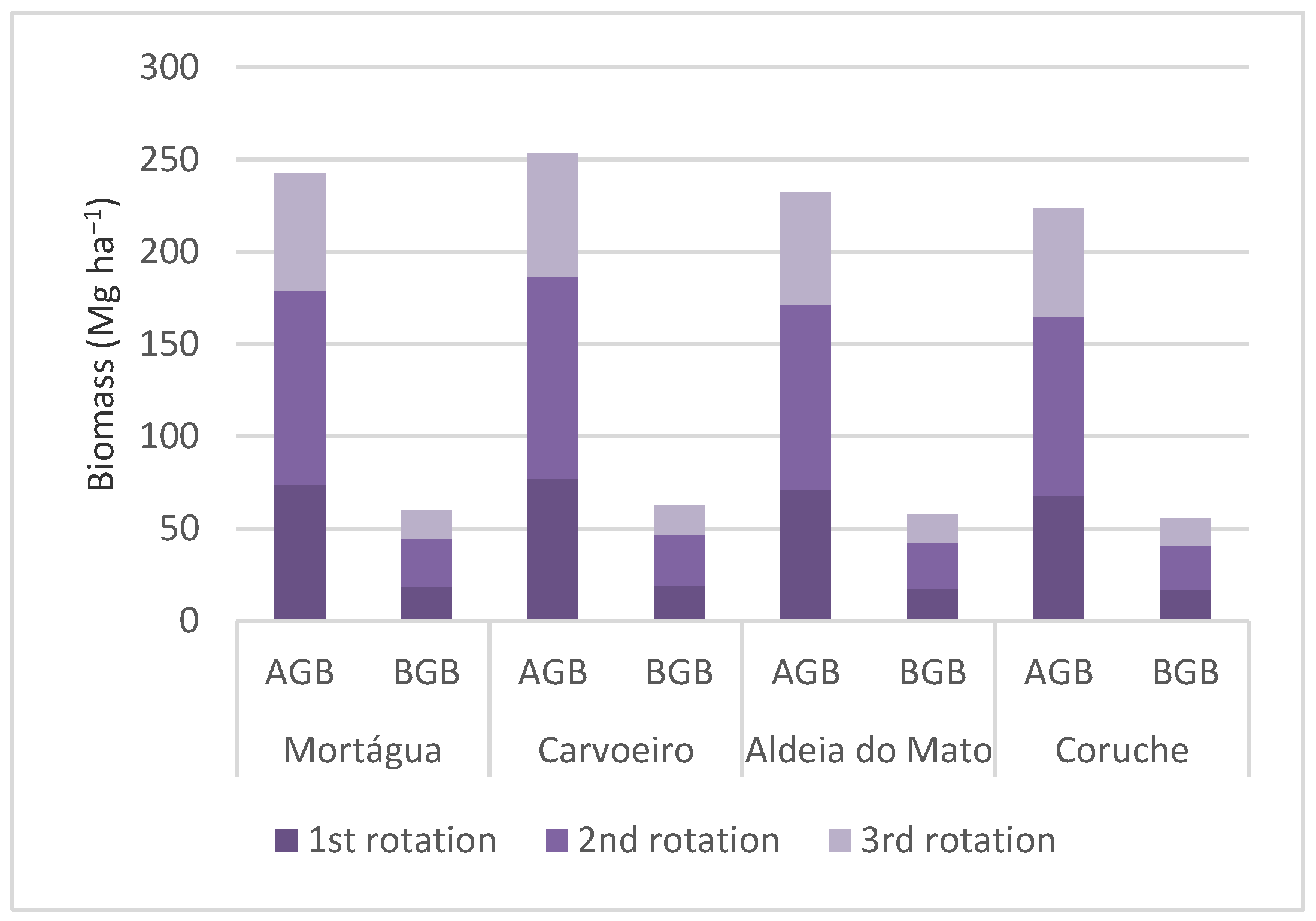
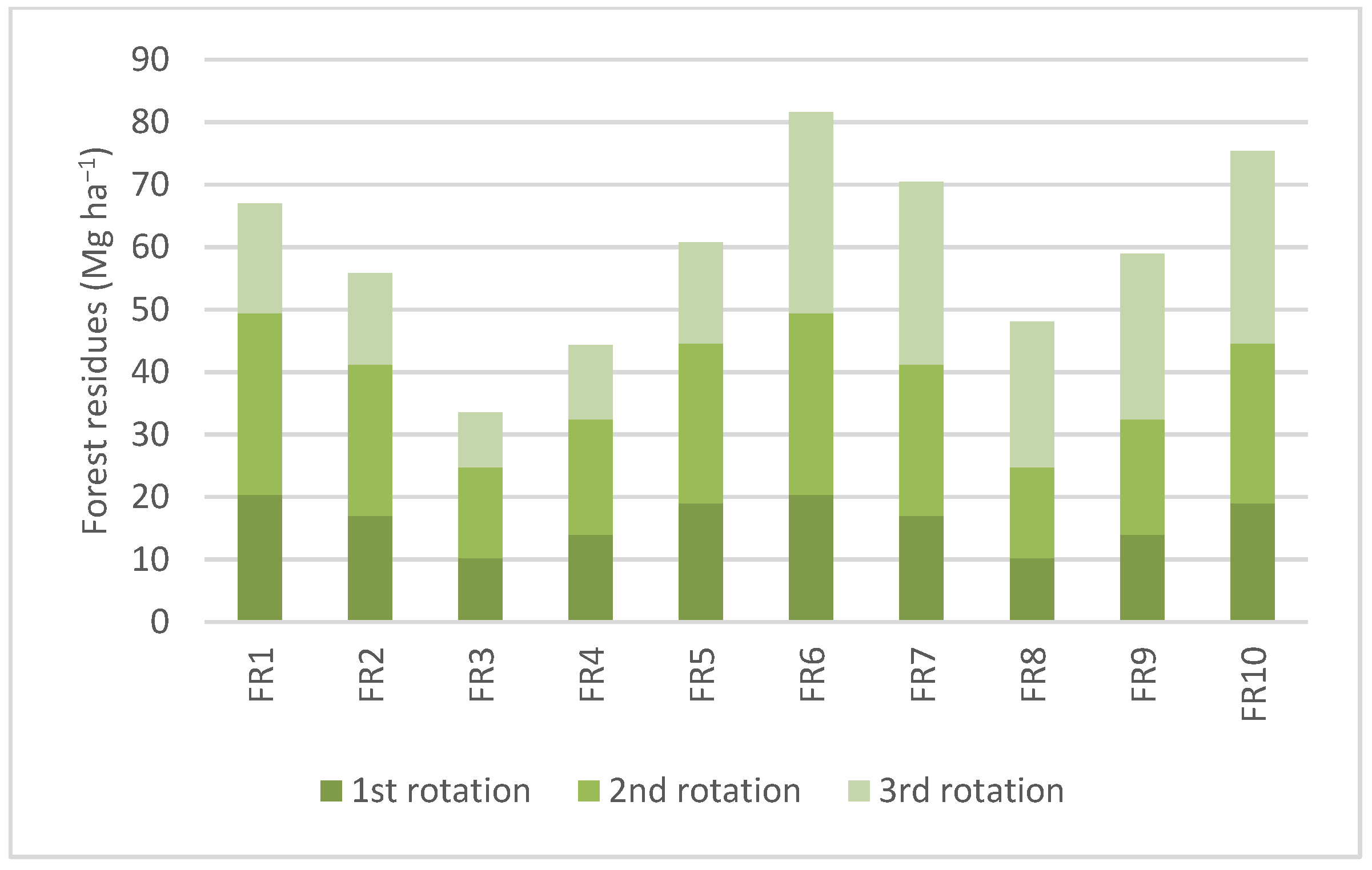
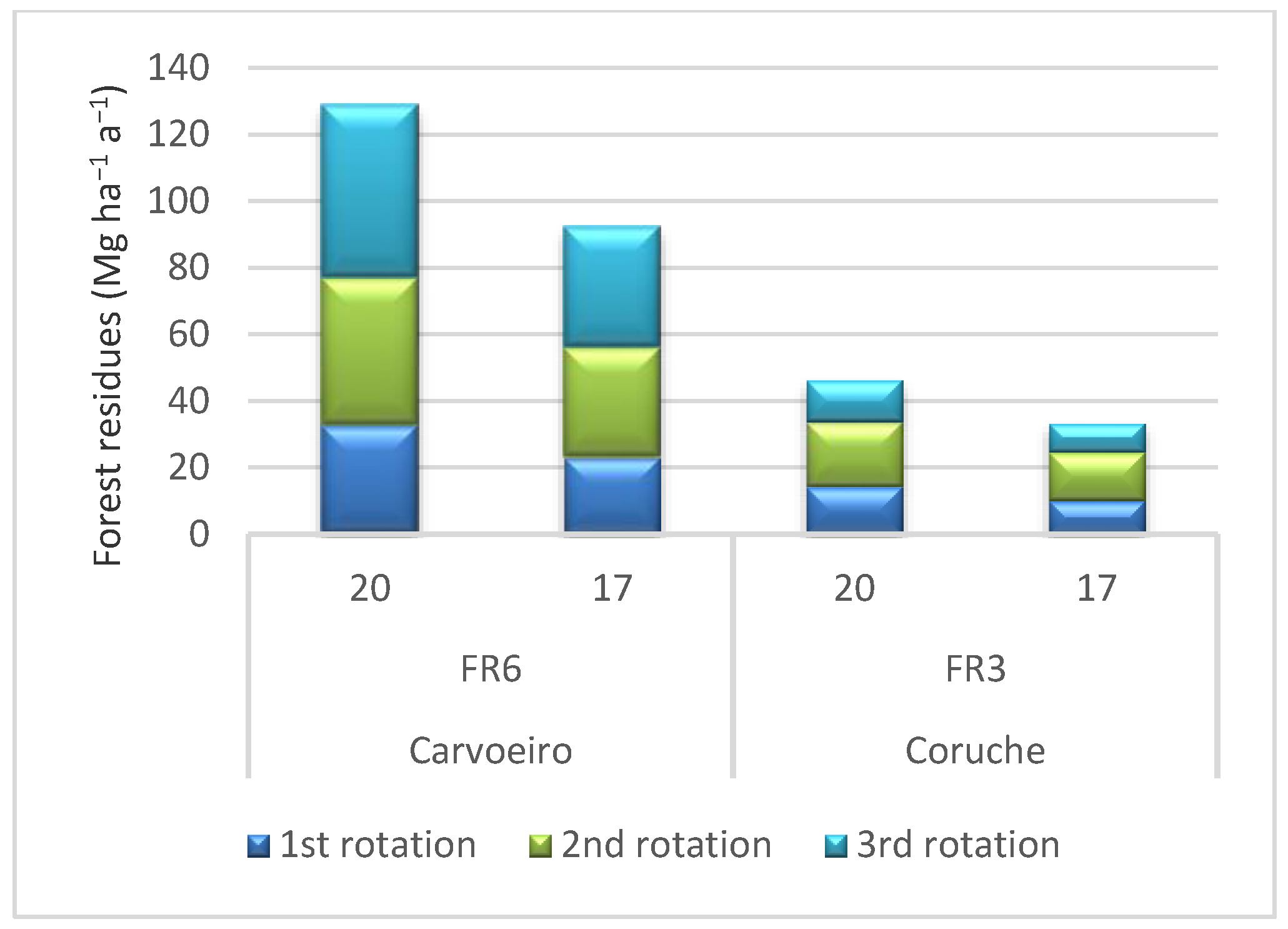
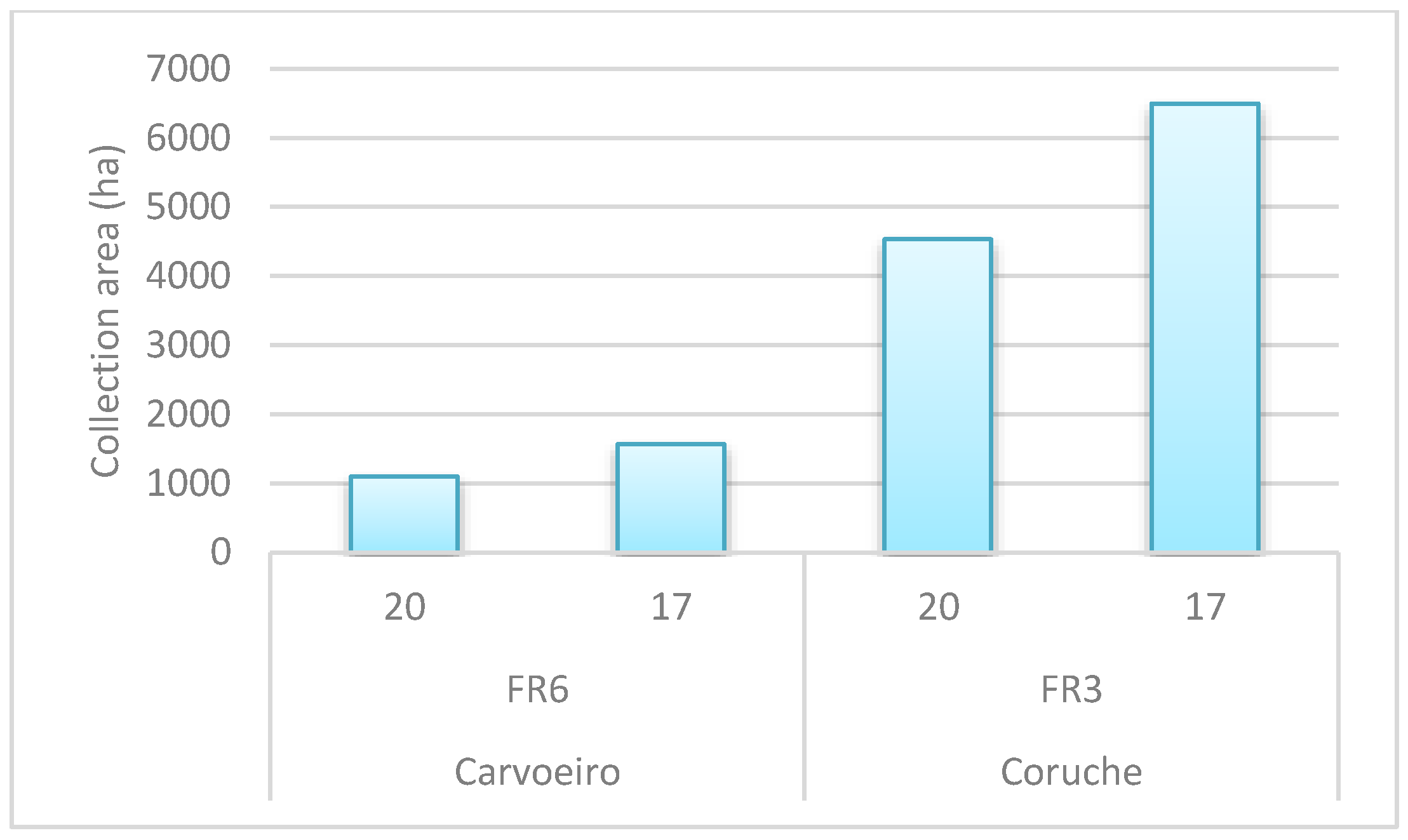
| Parameter | Mortágua | Carvoeiro | Aldeia do Mato | Coruche |
|---|---|---|---|---|
| Latitude | 40.4201 | 41.66509 | 39.52675 | 39.02265 |
| Longitude | −8.27277 | −8.65755 | −8.28049 | −8.57961 |
| Altitude (m) | 175 | 192 | 208 | 79 |
| Rainfall (days a−1) | 118.3 | 136 | 103.5 | 83.9 |
| Site index range | 16–28 | 14–26 | 13–25 | 11–23 |
| Scenarios | Residual Removals |
|---|---|
| FR1.0 | 30% of AGB |
| FR2.0 | 25% of AGB |
| FR3.0 | 15% of AGB |
| FR4.0 | 100% of bark, 100% of branch, and 25% of leaf biomass |
| FR5.0 | 100% of bark, 100% of branch, 25% of leaf, and 10% of stem biomass |
| FR1.1 | Scenario FR1.0 + 100% BGB at the end of the harvest cycle |
| FR2.1 | Scenario FR2.0 + 100% BGB at the end of the harvest cycle |
| FR3.1 | Scenario FR3.0 + 100% BGB at the end of the harvest cycle |
| FR4.1 | Scenario FR4.0 + 100% BGB at the end of the harvest cycle |
| FR5.1 | Scenario FR5.0 + 100% BGB at the end of the harvest cycle |
| Property | Wood | Stump | |
|---|---|---|---|
| Chemical and structural analysis (wt% dry) | Ash | - | 0.4 d |
| Extractives | - | 15.1 d | |
| Lignin | 22.2 a | 24.8 d | |
| Holocellulose | - | 67.0 d | |
| Cellulose | 51.1 a | - | |
| Hemicellulose | 26.7 a | - | |
| Proximate analysis (wt% dry) | Fixed Carbon | 17.30 b | 18.3 d |
| Volatile matter | 81.60 b | 81.1 d | |
| Ash | 1.1 b | 0.6 d | |
| Ultimate analysis (wt% dry) | C | 48.18 b | 51.0 d |
| H | 5.92 b | 5.8 d | |
| O | 44.18 b | 45.3 d | |
| N | 0.39 b | - 1,d | |
| S | 0.01 b | - 2,d | |
| Lower heating value (MJ kg−1) (dry) | 17.94 b | 17.7 d | |
| Basic density (g cm−3) | 0.533 c | 0.63 d | |
Publisher’s Note: MDPI stays neutral with regard to jurisdictional claims in published maps and institutional affiliations. |
© 2021 by the authors. Licensee MDPI, Basel, Switzerland. This article is an open access article distributed under the terms and conditions of the Creative Commons Attribution (CC BY) license (https://creativecommons.org/licenses/by/4.0/).
Share and Cite
Malico, I.; Gonçalves, A.C. Eucalyptus globulus Coppices in Portugal: Influence of Site and Percentage of Residues Collected for Energy. Sustainability 2021, 13, 5775. https://doi.org/10.3390/su13115775
Malico I, Gonçalves AC. Eucalyptus globulus Coppices in Portugal: Influence of Site and Percentage of Residues Collected for Energy. Sustainability. 2021; 13(11):5775. https://doi.org/10.3390/su13115775
Chicago/Turabian StyleMalico, Isabel, and Ana Cristina Gonçalves. 2021. "Eucalyptus globulus Coppices in Portugal: Influence of Site and Percentage of Residues Collected for Energy" Sustainability 13, no. 11: 5775. https://doi.org/10.3390/su13115775
APA StyleMalico, I., & Gonçalves, A. C. (2021). Eucalyptus globulus Coppices in Portugal: Influence of Site and Percentage of Residues Collected for Energy. Sustainability, 13(11), 5775. https://doi.org/10.3390/su13115775







